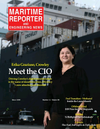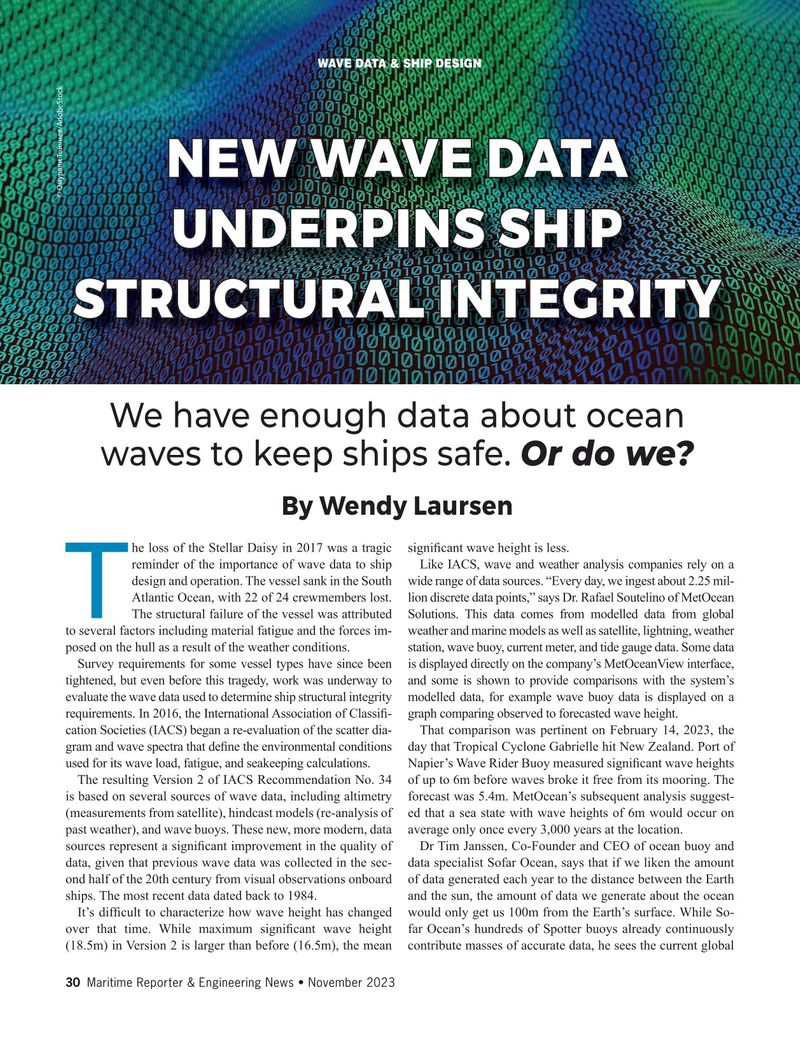
Page 30: of Maritime Reporter Magazine (November 2023)
Workboat Edition
Read this page in Pdf, Flash or Html5 edition of November 2023 Maritime Reporter Magazine
WAVE DATA & SHIP DESIGN
NEW WAVE DATA © ??????? ???????/AdobeStock
UNDERPINS SHIP
STRUCTURAL INTEGRITY
We have enough data about ocean waves to keep ships safe. Or do we?
By Wendy Laursen he loss of the Stellar Daisy in 2017 was a tragic signi? cant wave height is less. reminder of the importance of wave data to ship Like IACS, wave and weather analysis companies rely on a design and operation. The vessel sank in the South wide range of data sources. “Every day, we ingest about 2.25 mil-
Atlantic Ocean, with 22 of 24 crewmembers lost. lion discrete data points,” says Dr. Rafael Soutelino of MetOcean
T The structural failure of the vessel was attributed Solutions. This data comes from modelled data from global to several factors including material fatigue and the forces im- weather and marine models as well as satellite, lightning, weather posed on the hull as a result of the weather conditions. station, wave buoy, current meter, and tide gauge data. Some data
Survey requirements for some vessel types have since been is displayed directly on the company’s MetOceanView interface, tightened, but even before this tragedy, work was underway to and some is shown to provide comparisons with the system’s evaluate the wave data used to determine ship structural integrity modelled data, for example wave buoy data is displayed on a requirements. In 2016, the International Association of Classi? - graph comparing observed to forecasted wave height.
cation Societies (IACS) began a re-evaluation of the scatter dia- That comparison was pertinent on February 14, 2023, the gram and wave spectra that de? ne the environmental conditions day that Tropical Cyclone Gabrielle hit New Zealand. Port of used for its wave load, fatigue, and seakeeping calculations. Napier’s Wave Rider Buoy measured signi? cant wave heights
The resulting Version 2 of IACS Recommendation No. 34 of up to 6m before waves broke it free from its mooring. The is based on several sources of wave data, including altimetry forecast was 5.4m. MetOcean’s subsequent analysis suggest- (measurements from satellite), hindcast models (re-analysis of ed that a sea state with wave heights of 6m would occur on past weather), and wave buoys. These new, more modern, data average only once every 3,000 years at the location.
sources represent a signi? cant improvement in the quality of Dr Tim Janssen, Co-Founder and CEO of ocean buoy and data, given that previous wave data was collected in the sec- data specialist Sofar Ocean, says that if we liken the amount ond half of the 20th century from visual observations onboard of data generated each year to the distance between the Earth ships. The most recent data dated back to 1984. and the sun, the amount of data we generate about the ocean
It’s dif? cult to characterize how wave height has changed would only get us 100m from the Earth’s surface. While So- over that time. While maximum signi? cant wave height far Ocean’s hundreds of Spotter buoys already continuously (18.5m) in Version 2 is larger than before (16.5m), the mean contribute masses of accurate data, he sees the current global 30 Maritime Reporter & Engineering News • November 2023
MR #11 (18-33).indd 30 11/2/2023 9:20:21 AM

 29
29

 31
31
